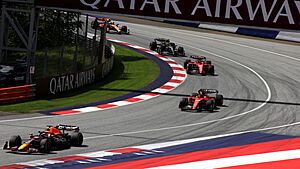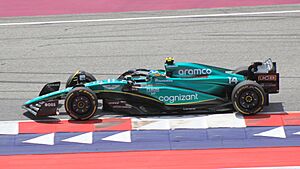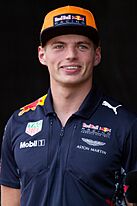2023 Formula One World Championship facts for kids
| 2023 FIA Formula One World Championship |
|||
| Drivers' Champion: Max Verstappen Constructors' Champion: Red Bull Racing-Honda RBPT |
|||
| Previous: | 2022 | Next: | 2024 |
|
Support series: Formula 2 Championship FIA Formula 3 Championship Porsche Supercup |
|||
The 2023 FIA Formula One World Championship was a super exciting motor racing competition. It was the 74th time the Formula One World Championship was held. This championship is the top level for open-wheel racing cars and is managed by the Fédération Internationale de l'Automobile (FIA).
Drivers and teams raced for two big titles: the World Drivers' Champion and the World Constructors' Champion. The 2023 season was mostly won by Max Verstappen. He won his third straight Drivers' Championship at the Qatar Grand Prix. Max won an amazing 19 out of 22 races and finished on the podium 21 times, which are both records!
His team, Red Bull Racing, also won their sixth Constructors' Championship. They won 21 out of 22 races, setting a new team record for winning 95.45% of the races. The only other team to win a race was Ferrari, thanks to Carlos Sainz Jr. at the Singapore Grand Prix.
Contents
Who Raced in 2023?
All the teams used special tyres made by Pirelli. Each team had to have two drivers for every race.
Driver Changes: New Faces on the Grid
Some drivers changed teams or joined Formula 1 for the first time in 2023.
- Sebastian Vettel retired after 15 seasons. Fernando Alonso took his spot at Aston Martin.
- Pierre Gasly moved from AlphaTauri to Alpine.
- Nyck de Vries, a champion from other racing series, joined AlphaTauri.
- Daniel Ricciardo left McLaren. His spot was filled by Oscar Piastri, who made his F1 debut.
- Nicholas Latifi left Williams. Logan Sargeant joined Williams, becoming the first American F1 driver since 2015.
- Mick Schumacher left Haas. Nico Hülkenberg returned to full-time racing with Haas.
Mid-Season Driver Changes
During the season, Nyck de Vries was replaced at AlphaTauri by Daniel Ricciardo. Later, Ricciardo broke his hand in a crash. Liam Lawson, a reserve driver, stepped in for a few races. Lawson made his F1 debut at the Dutch Grand Prix. Ricciardo returned to racing at the United States Grand Prix.
The 2023 Race Calendar
The 2023 season had 22 races, called Grands Prix. Some races, like Azerbaijan and Qatar, also had a special "sprint" format.
Calendar Changes
The Qatar Grand Prix returned in 2023 after not being held in 2022. The exciting Las Vegas Grand Prix also made its debut, with a new street track on the famous Las Vegas Strip. This meant the United States hosted three F1 races in one season for the first time since 1982.
Some races were removed or cancelled. The Russian Grand Prix was taken off the calendar. The French Grand Prix was also removed, with plans for it to possibly return later by sharing its spot with other races. The Chinese Grand Prix was cancelled for the fourth year in a row due to the COVID-19 pandemic. The Emilia Romagna Grand Prix was cancelled due to severe flooding in the area.
New Rules for 2023 F1 Cars
The FIA, which makes the rules, brought in some changes for 2023 to make racing safer and fairer.
Safety Changes
After cars bounced a lot in 2022 (called "porpoising"), rules were changed to reduce this. The floor edges of the cars were raised, and a new sensor was added to monitor the bouncing.
Following a big crash in 2022, the roll hoop (a safety structure above the driver's head) had to be rounded. This helps prevent it from digging into the ground during an accident. Also, side mirrors were made bigger to help drivers see better behind them.
Weight and Fuel Rules
The planned weight reduction for cars was cancelled. Rules about minimum fuel temperature were also changed. Fuel now had to be at least 10°C or 10°C below the outside temperature, whichever was lower.
Aerodynamics
Rules about front wings were clarified. This happened after Mercedes found a clever way to design their front wing. The new rules made sure that parts like "slot gap separators" were mainly for structure, not just for aerodynamic advantage.
Sporting Rules
There were only three days of pre-season testing, less than in 2022. Rules about team radio messages were made less strict. Also, most COVID-19 safety rules, like needing proof of vaccination, were removed.
Tyre Changes
Pirelli, the tyre supplier, introduced a new tyre compound. This gave teams more choices for their race strategies. A new full wet tyre was also introduced to improve racing in rainy conditions.
F1 also tried a new rule to use fewer tyres at some races. Teams had to use specific tyre types in different parts of qualifying. This was done to make tyre use more sustainable.
Sprint Race Changes
The "sprint" format was used at six races in 2023, more than before. The schedule for sprint weekends changed. Friday had one practice and then qualifying for Sunday's main race. Saturday had a new "sprint shootout" qualifying session, which set the grid for the sprint race later that day. The main Grand Prix was still on Sunday.
Points System
The rules for how points are given were made clearer. If a race ended early, drivers would get fewer points based on how much of the race was completed. This applied whether the race ended under a red flag or not.
Political Statements
The FIA updated its rules about drivers making "political, religious, and personal statements." Drivers now need permission from the FIA before making such statements during race events. This rule was put in place to keep the sport neutral, similar to the International Olympic Committee's rules. Drivers can still share their opinions on social media or in press conferences outside of race weekends.
Financial Rules
The budget cap, which limits how much teams can spend, was set at $135 million. This cap was adjusted to account for inflation and the number of races. Teams also agreed to let the FIA check their factories more easily to make sure they follow the budget rules. A winter break for factories was also introduced.
How the Season Unfolded
Pre-season Testing
Teams tested their new cars in Bahrain from February 23-25. Red Bull Racing's Sergio Pérez set the fastest time.
Opening Races
Red Bull Racing started strong at the Bahrain Grand Prix. Max Verstappen won easily, followed by his teammate Sergio Pérez. Fernando Alonso of Aston Martin finished third.
At the Saudi Arabian Grand Prix, Pérez took pole position. Verstappen started 15th but fought his way to second place. Pérez won the race, with Alonso again finishing third.
The Australian Grand Prix was full of action with three red flags. Verstappen won, with Lewis Hamilton second and Alonso third. McLaren and Scuderia AlphaTauri scored their first points of the season.
The Azerbaijan Grand Prix had the first sprint event. Charles Leclerc took pole for both the sprint and the main race. Pérez won the sprint and the Grand Prix, with Verstappen second in both.
At the Miami Grand Prix, Pérez was on pole, but Verstappen, starting ninth, quickly moved through the field to win the race.
Verstappen also won the Monaco Grand Prix in tricky wet conditions. Alonso finished second, and Esteban Ocon got a rare podium for Alpine in third.
Verstappen continued his winning streak at the Spanish Grand Prix, taking a "grand slam" (pole, win, fastest lap, leading every lap). Mercedes drivers Hamilton and George Russell finished second and third.
Mid-Season Races

Verstappen won the Canadian Grand Prix, giving Red Bull Racing their 100th F1 victory. Alonso and Hamilton battled for the other podium spots, with Alonso finishing second.
Verstappen also dominated the Austrian Grand Prix, winning both the sprint and the main race. He led every lap of the Grand Prix.
At the British Grand Prix, McLaren showed great improvement. Lando Norris and Oscar Piastri qualified well. Verstappen won, with Norris finishing second and Hamilton third.
The Hungarian Grand Prix saw Daniel Ricciardo return to racing. Hamilton took pole position, but Verstappen won the race, making it seven wins in a row for him. Red Bull Racing also set a new record with 12 consecutive team victories.
Verstappen continued his winning ways at the Belgian Grand Prix, winning both the sprint and the Grand Prix.
At the Dutch Grand Prix, Verstappen won his home race. Liam Lawson made his F1 debut, replacing the injured Daniel Ricciardo.
Verstappen broke the record for most consecutive wins at the Italian Grand Prix, winning his tenth race in a row. Carlos Sainz Jr. took pole position for Ferrari.
Closing Races

The Singapore Grand Prix was the only race not won by Red Bull. Carlos Sainz Jr. won for Ferrari, ending Verstappen's winning streak.
Verstappen returned to winning at the Japanese Grand Prix. This win also secured the World Constructors' Championship for Red Bull Racing.
At the Qatar Grand Prix, Oscar Piastri won the sprint race, his first F1 victory. In the main race, Verstappen won, securing his third consecutive Drivers' Championship! The race was very hot, causing problems for many drivers.
The United States Grand Prix saw Verstappen win again. However, after the race, Hamilton and Leclerc were disqualified due to car issues, promoting Norris to second and Sainz to third.
Charles Leclerc took pole at the Mexico City Grand Prix. Verstappen won the race, setting a new record for 16 wins in a single season.
The São Paulo Grand Prix had another sprint race, won by Verstappen. He also won the main Grand Prix, his 17th win of the season.

The season ended with the Abu Dhabi Grand Prix. Max Verstappen took pole position and won the race, finishing his record-breaking season.
Season Highlights and Records
The 2023 season was truly amazing for Max Verstappen and Red Bull Racing. They broke many records:
- Verstappen won 19 Grands Prix, the most ever in a single season.
- He had a win rate of 86.36%, beating a record from 1952.
- Verstappen also had 21 podium finishes, another record.
- Red Bull Racing won 21 out of 22 races, setting a team record with a 95.45% win rate.
While Verstappen was super dominant, his teammate Sergio Pérez had a tougher season. He struggled with qualifying, which meant he often started further back.
Mercedes finished second in the Constructors' Championship, but they were disappointed with their car's performance. Lewis Hamilton still managed to finish third in the Drivers' Championship, which was impressive given the car's struggles.
Ferrari also hoped to challenge for the title but couldn't keep up with Red Bull. They had some good moments, like Sainz's win in Singapore.
McLaren had a tough start but improved a lot during the season with car upgrades. Oscar Piastri had a "phenomenal" rookie season and won the FIA Rookie of the Year award. Aston Martin started strong with Fernando Alonso getting many podiums, but their performance dropped later in the year.
Williams showed good improvement, finishing seventh in the constructors' standings. Alexander Albon performed very well for them. AlphaTauri had an inconsistent season, using four different drivers. Yuki Tsunoda was praised for his driving.
Alfa Romeo and Haas finished lower down the standings. Haas had some good qualifying results but struggled with race pace. The 2023 season was also the first since 1952 where the British national anthem was not played on the podium, as no British driver won a race.
Race Results and Standings
Grands Prix
How Points Were Awarded
Points were given to the top ten drivers in each Grand Prix. An extra point was given for the fastest lap, but only if that driver finished in the top ten. For sprint races, points were given to the top eight drivers. If drivers had the same number of points, the one with more wins was ranked higher.
| Position | 1st | 2nd | 3rd | 4th | 5th | 6th | 7th | 8th | 9th | 10th | FL |
|---|---|---|---|---|---|---|---|---|---|---|---|
| Race | 25 | 18 | 15 | 12 | 10 | 8 | 6 | 4 | 2 | 1 | 1 |
| Sprint | 8 | 7 | 6 | 5 | 4 | 3 | 2 | 1 | |||
World Drivers' Championship Standings
Here are the top drivers at the end of the 2023 season:
- 1. Max Verstappen (Red Bull Racing) - 575 points
- 2. Sergio Pérez (Red Bull Racing) - 285 points
- 3. Lewis Hamilton (Mercedes) - 234 points
- 4. Fernando Alonso (Aston Martin) - 206 points
- 5. Charles Leclerc (Ferrari) - 206 points
- 6. Lando Norris (McLaren) - 205 points
- 7. Carlos Sainz Jr. (Ferrari) - 200 points
- 8. George Russell (Mercedes) - 175 points
- 9. Oscar Piastri (McLaren) - 97 points
- 10. Lance Stroll (Aston Martin) - 74 points
World Constructors' Championship Standings
Here are the top teams at the end of the 2023 season:
- 1. Red Bull Racing-Honda RBPT - 860 points
- 2. Mercedes - 409 points
- 3. Ferrari - 406 points
- 4. McLaren-Mercedes - 302 points
- 5. Aston Martin Aramco-Mercedes - 280 points
- 6. Alpine-Renault - 120 points
- 7. Williams-Mercedes - 28 points
- 8. AlphaTauri-Honda RBPT - 25 points
- 9. Alfa Romeo-Ferrari - 16 points
- 10. Haas-Ferrari - 12 points
See also
 In Spanish: Temporada 2023 de Fórmula 1 para niños
In Spanish: Temporada 2023 de Fórmula 1 para niños












